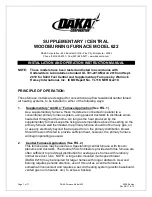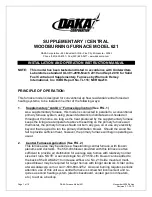
W415-1243 / E / 11.27.17
24
IOM
IOM
9.4 FURNACE VENTING INSTALLATIONS
9.4.1 NON-DIRECT VENT INSTALLATION USING INDOOR COMBUSTION
AIR (ONE PIPE SYSTEM)
9.4.2 DIRECT VENT INSTALLATION USING OUTDOOR COMBUSTION AIR
(TWO PIPE SYSTEM)
9.4.3 COMBUSTION AIR
H14.3
•
Locate the vent terminal 3 feet (0.91m) above any forced air inlet located within 10 feet (3m). Any fresh air
or make-up air inlet, such as for a dryer or furnace area is considered a forced air inlet.
The vent terminal should be located no fewer than 3 feet (0.91m) from an inside corner formed by two exterior walls.
Recommended clearance from overhangs is a minimum of 1 foot (0.3m) vertically for each foot horizontally up
to 6 feet (1.8m).
H3.14
READ AND FOLLOW ALL INSTRUCTIONS IN THIS SECTION. FAILURE TO PROPERLY
VENT THIS FURNACE CAN CAUSE CARBON MONOXIDE POISONING OR AN EXPLOSION
OR FIRE RESULTING IN PROPERTY DAMAGE, PERSONAL INJURY OR LOSS OF LIFE.
WARNING
!
!
H14.4A
Non-direct vent installations require only a vent pipe. This may be desirable when using outdoor combustion
air is not practical.
• Provisions are not made for routing of combustion air;
• The outdoor environment may contain contaminants undesirable for combustion.
• Install and secure a 8
"
(20 cm) piece of intake air pipe with a 90° elbow to prevent objects from
entering burner area, and or objects from blocking combustion air intake
.
H14.5
The direct vent con
fi
guration is the preferred installation method. The primary advantages are:
• No special kit or modi
fi
cations are required for direct vent installations
• Dedicated combustion air and vent piping eliminates the need to use already heated air for combustion
purposes;
• The probability of corrosive contaminants being present in the combustion air is greatly reduced;
• The direct vent con
fi
guration is unaffected by any other appliances, exhaust fans, or other devices that
tend to create negative pressure conditions while operating.
• No vents for combustion and ventilation air are required in con
fi
ned spaces.
H14.6
This furnace is certi
fi
ed as a Category IV Type FSP Non-Direct and Direct Vent Furnace. When installed
as a direct vent furnace, all combustion air is supplied from the outdoors via the plastic piping system. All
components are
fi
eld supplied, except for the 2” PVC connector used to connect the combustion air piping to
the furnace.
The combustion air piping, like the exhaust piping, must be air tight throughout the system. The adapter joining
the combustion air to the furnace is supplied with one gasket.
IMPORTANT
:
• IF PLANNING TO USE ABS PIPE, USE AN ALL-PURPOSE CLEANER AND ABS
TO PVC TRANSITION CEMENT. IF PLANNING TO USE CPVC PIPE, USE AN ALL-
PURPOSE CLEANER, A CLEAR OR PURPLE PRIMER AND ALL-PURPOSE CEMENT
APPROVED FOR THE PURPOSE.
• ADDITIONAL INFORMATION ABOUT CLEANERS, PRIMERS, SOLVENTS AND
CEMENTS MAY BE OBTAINED FROM THEIR MANUFACTURERS.
• IF THE FURNACE IS TO BE INSTALLED IN THE VICINITY OF OTHER FUEL BURNING
APPLIANCES, ADEQUATE COMBUSTION AIR MUST BE AVAILABLE FOR THE NON-
DIRECT VENT APPLIANCES. SEE SECTION 8.1,
“DETERMINING COMBUSTION AIR”.
Summary of Contents for ULTIMATE 9700 Series
Page 27: ...W415 1243 E 11 27 17 27 IOM FIGURE 14A DIRECT VENT TERMINAL CLEARANCES...
Page 28: ...W415 1243 E 11 27 17 28 IOM IOM FIGURE 14B NON DIRECT VENT TERMINAL CLEARANCES...
Page 58: ...W415 1243 E 11 27 17 58 IOM IOM 23 0 SERVICE HISTORY 43 1...
Page 74: ...6 0 NOTES 44 1 W415 1243 E 11 27 17 UM 74...








































